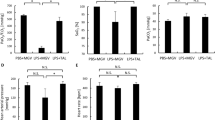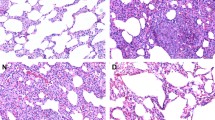Abstract
We have studied whether hyperbaric oxygen (HBO) prevents different pulmonary aspiration materials-induced lung injury in rats. The experiments were designed in 60 Sprague-Dawley rats, ranging in weight from 250 to 300 g, randomly allotted into one of six groups (n = 10): saline control, Biosorb Energy Plus (BIO), hydrochloric acid (HCl), saline + HBO treated, BIO + HBO treated, and HCl + HBO treated. Saline, BIO, HCl were injected into the lungs in a volume of 2 ml/kg. A total of seven HBO sessions were performed at 2,4 atm 100% oxygen for 90 min at 6-h intervals. Seven days later, rats were sacrificed, and both lungs in all groups were examined biochemically and histopathologically. Our findings show that HBO inhibits the inflammatory response reducing significantly (P < 0.05) peribronchial inflammatory cell infiltration, alveolar septal infiltration, alveolar edema, alveolar exudate, alveolar histiocytes, interstitial fibrosis, granuloma, and necrosis formation in different pulmonary aspiration models. Pulmonar aspiration significantly increased the tissue HP content, malondialdehyde (MDA) levels and decreased (P < 0.05) the antioxidant enzyme (SOD, GSH-Px) activities. HBO treatment significantly (P < 0.05) decreased the elevated tissue HP content, and MDA levels and prevented inhibition of SOD, and GSH-Px (P < 0.05) enzymes in the tissues. Furthermore, there is a significant reduction in the activity of inducible nitric oxide synthase, TUNEL and arise in the expression of surfactant protein D in lung tissue of different pulmonary aspiration models with HBO therapy. It was concluded that HBO treatment might be beneficial in lung injury, therefore, shows potential for clinical use.



Similar content being viewed by others
References
Ahrens P, Noll C, Kitz R, Willigens P, Zielen S, Hofmann D (1999) Lipid-laden alveolar macrophages: a useful marker of silent aspiration in children. Pediatr Pulmonol 28:83–88
Aksu B, Inan M, Kanter M, Ozpuyan F, Uzun H, Durmus-Altun G, Gurcan S, Aydın S, Ayvaz S, Pul M (2007) The effects of methylene blue on renal scarring due to pyelonephritis in rats. Pediatr Nephrol 22(7):992–1001
Bachofen M, Weibel ER (1982) Structural alterations of lung parenchyma in the adult respiratory distress syndrome. Clin Chest Med 3:35–56
Bauer ML, Lyrene RK (1999) Chronic aspiration in children: evaluation of the lipid-laden macrophage index. Pediatr Pulmonol 28:94–100
Bhatia M, Moochhala S (2004) Role of inflammatory mediators in the pathophysiology of acute respiratory distress syndrome. J Pathol 202(2):145–156
Bogdan C (2001) Nitric oxide and immune response. Nat Immunol 2:907–916
Botas C, Poulain F, Akiyama J, Brown C, Allen L, Goerke J, Clements J, Carlson E, Gillespie AM, Epstein C, Hawgood S (1998) Altered surfactant homeostasis and alveolar type II cell morphology in mice lacking surfactant protein D. Proc Natl Acad Sci 95:1869–1874
Cheng IW, Ware LB, Greene KE, Nuckton TJ, Eisner MD, Matthay MA (2003) Prognostic value of surfactant proteins A and D in patients with acute lung injury. Crit Care Med 31:20–27
Cook DJ, Walter SD, Cook RJ, Guyatt GH, Leasa D, Jaeschke RZ, Brun-Buisson C (1998) Incidence of and risk factors for ventilator-associated pneumonia in critically ill patients. Ann Intern Med 129:433–440
Crouch EC (1998) Collectins and pulmonary host defense. Am J Respir Cell Mol Biol 19:177–201
Davidson BA, Knight PR, Helinski JD, Nader ND, Shanley TP, Johnson KJ (1999) The role of tumor necrosis factor-alpha in the pathogenesis of aspiration pneumonitis in rats. Anesthesiology 91:486–499
Downey GP, Dong Q, Kruger J, Dedhar S, Cherapanov V (1999) Regulation of neutrophil activation in acute lung injury. Chest 116:46–54
Drakulovic MB, Torres A, Bauer TT, Nicolas JM, Nogué S, Ferrer M (1999) Supine body position as a risk factor for nosocomial pneumonia in mechanically ventilated patients: a randomised trial. Lancet 354:1851–1858
Elpern EH, Jacobs ER, Tangney C, Stone KS, Frank PA, Clouse RE (1986) Nonspecificity of glucose reagent strips as a marker of Formula. Am Rev Respir Dis 131:A288
Folkesson HG, Matthay MA, Hebert CA, Broaddus VC (1995) Acid aspiration-induced lung injury in rabbits is mediated by interleukin-8-dependent mechanisms. J Clin Invest 96:107–116
Garzón Lorenzo P, Torrent Vernetta A, Server Salva L, de Vicente CM, García-Cendón C, Gartner S (2008) Exogenous lipoid pneumonia. An Pediatr (Barc) 68(5):496–498
Gill AL, Bell CN (2004) Hyperbaric oxygen: its uses, mechanisms of action and outcomes. QJM 97:385–395
Guzel A, Basaran U, Aksu B, Kanter M, Yalcın O, Aktas C, Guzel A, Karasalıhoglu K (2008) Protective effects of S-methylisothiourea sulfate on different aspiration materials-induced lung injury in rats. Int J Pediatr Otorhinolaryngol 72(8):1241–1250
Guzel A, Kanter M, Aksu B, Basaran UN, Yalcın O, Guzel A, Uzun H, Konukoglu D, Karasalihoglu S (2009) Preventive effects of curcumin on different aspiration material-induced lung injury in rats. Pediatr Surg Int 25:83–92
Harabin AL, Braisted JC, Flynn ET (1990) Response of antioxidant enzymes to intermittent and continuous hyperbaric oxygen. J Appl Physiol 69(1):328–335
Harkin DW, Rubin BB, Romaschin A, Lindsay TF (2004) Selective inducible nitric oxide synthase (iNOS) inhibition attenuates remote acute lung injury in a model of ruptured abdominal aortic aneurysm. J Surg Res 120:230–241
Herbein JF, Wright JR (2001) Enhanced clearance of surfactant protein D during LPS-induced acute inflammation in rat lung. Am J Physiol Lung Cell Mol Physiol 281:268–277
Hills BA (1999) A role for oxygen-induced osmosis in hyperbaric oxygen therapy. Med Hypotheses 52:259–263
Hsu SM, Raine L, Fanger H (1981) Use of Avidin-Biotin-Peroxidase complex (ABC) in immunoperoxidase techniques: a comparison between ABC and unlabeled antibody (PAP) procedures. J Histochem Cytochem 29:577–580
Ikegami M, Scoville EA, Grant S, Korfhagen T, Brondyk W, Scheule RK, Whitsett JA (2007) Surfactant protein-D and surfactant inhibit endotoxin-induced pulmonary inflammation. Chest 13:1447–1454
Jamieson D (1991) Lipid peroxidation in brain and lungs from mice exposed to hyperoxia. Biochem Pharmacol 41(5):749–756
Kanter M (2009) Effects of Nigella sativa seed extraction ameliorating lung tissue damage in rats after experimental pulmonary aspirations. Acta Histochem 111:393–403
Kinsey GC, Murray MJ, Swensen SJ, Bone RC (1994) Glucose content of tracheal aspirates: implications for the detection of tube feeding aspiration. Crit Care Med 22:1557–1562
Kivirikko KI, Laitinen O, Prockop DJ (1967) Modifications of a specific assay for hydroxyproline in urine. Anal Biochem 19:249–255
Kudoh L, Miyazaki H, Ohara M, Fukushima J, Tazawa T, Yamada H (2001) Activation of alveolar macrophages in acid injured lung in rats: different effect of pentoxifylline on tumor necrosis factor-alpha and nitric oxide production. Crit Care Med 29:1621–1625
Lee KH, Rico P, Billiar TR, Pinsky MR (1998) Nitric oxide production after acute, unilateral hydrochloric acid-induced lung injury in a canine model. Crit Care Med 26:2042–2047
Leth-Larsen R, Nordenback C, Tornoe I, Moeller V, Schlosser A, Koch C, Teisner B, Junker P, Holmskov U (2003) Surfactant protein D (SP-D) serum levels in patients with community-acquired pneumonia. Clin Immunol 108:29–37
Lowry OH, Rosenbrough NJ, Farr AC, Randall RJ (1951) Protein measurement with the folin phenol regent. J Biol Chem 193:265–275
Marik PE (2001) Aspiration pneumonitis and aspiration pneumonia. N Engl J Med 344:665–671
Metheny NA, Dahms TE, Stewart BJ, Stone KS, Edwards SJ, Defer JE, Clouse RE (2002) Efficacy of dye-stained enteral formula in detecting pulmonary aspiration. Chest 122:276–281
Metheny NA, Dahms TE, Stewart BJ, Stone KS, Frank PA, Clouse RE (2005) Verification of inefficacy of the glucose method in detecting aspiration associated with tube feedings. Medsurg Nurs 14:112–119
Metheny NA, Clouse RE, Chang YH, Stewart BJ, Oliver DA, Kollef MH (2006) Tracheobronchial aspiration of gastric contents in critically ill tube-fed patients: frequency, outcomes, and risk factors. Crit Care Med 34:1007–1015
Metnitz PG, Bartens C, Fischer M, Fridrich P, Steltzer H, Druml W (1999) Antioxidant status in patients with acute respiratory distress syndrome. Intensive Care Med 25(2):180–185
Miyakawa H, Sato K, Shinbori T, Okamoto T, Gushima Y, Fujiki M, Suga M (2002) Effects of inducible nitric oxide synthase and xanthine oxidase inhibitors on SEB-induced interstitial pneumonia in mice. Eur Respir J 19:447–457
Ohkawa H, Oshishi N, Yagi K (1979) Assay of lipid peroxidation in animal tissue by thiobarbituric acid reaction. Anal Biochem 95:351–358
Paglia DE, Valentine WN (1967) Studies on the quantitative and qualitative characterisation of erythrocyte glutathione peroxidase. J Lab Clin Med 70:158–169
Potts RG, Zaroukian MH, Guerrero PA, Potts RG, Zaroukian MH, Guerrero PA, Baker CD (1993) Comparison of blue dye visualization and glucose oxidase test strip methods for detecting pulmonary aspiration of enteral feedings in intubated adults. Chest 103:117–121
Shepherd KE, Faulkner CS, Thal GD, Leiter JC (1995) Acute, subacute, and chronic histologic effects of simulated aspiration of a 0.7% sucralfate suspension in rats. Crit Care Med 23:532–536
Slotman GJ (1998) Hyperbaric oxygen in systemic inflammation HBO is not just a movie channel anymore. Crit Care Med 26(12):1932–1933
Speyer CL, Neff TA, Warner RL, Guo RF, Sarma JV, Riedemann NC, Murphy ME, Ward PA (2003) Regulatory effects of iNOS on acute lung inflammatory responses in mice. Am J Pathol 163:2319–2328
Sun Y, Oberley LW, Li Y (1988) A simple method for clinical assay of superoxide dismutase. Clin Chem 34:497–500
Takil A, Umuroglu T, Gogus YF, Eti Z, Yildizeli B, Ahiskali R (2003) Histopathologic effects of lipid content of enteral solutions after pulmonary aspiration in rats. Nutrition 19:666–669
Tasaka S, Amaya F, Hashimoto S, Ishızaka A (2008) Roles of oxidants and redox signaling in the pathogenesis of acute respiratory distress syndrome. Antioxid Redox Signal 10(4):739–753
Tibbles PM, Edelsberg JS (1996) Hyperbaric-oxygen therapy. N Engl J Med 334:1642–1648
Torres A, Serra-Batlles J, Ros E, Piera C, Puig de la Bellacasa J, Cobos A, Lomena F, Rodriguez-Roisin R (1992) Pulmonary aspiration of gastric contents in patients receiving mechanical ventilation: the effect of body position. Ann Intern Med 116:540–543
Umuroglu T, Takıl A, Irmak P, Yıldızeli B, Ahıskalı R, Doğan V, Göğüs FY (2006) Effects of multiple pulmonary aspirations of enteral solutions on lung tissue damage. Clin Nutr 25:45–50
Winterbauer RH, Durning RBJ, Baron E, McFadden MC (1981) Aspirated nasogastric feeding solution detected by glucose strips. Ann Intern Med 95:67–68
Wright JL (1998) Aspiration pneumonia. In: Thurlbeck WM (ed) Pathology of the lung, Chap. 25, 2nd edn. Thieme Medical Publishers, New York
Yavagal DR, Karnad DR, Oak JL (2000) Metoclopramide for preventing pneumonia in critically ill patients receiving enteral tube feeding: a randomized controlled trial. Crit Care Med 28:1408–1411
Acknowledgments
This study was supported as Project TUBAB 2010-179 by Trakya University Research Center, Edirne, Turkey.
Author information
Authors and Affiliations
Corresponding author
Rights and permissions
About this article
Cite this article
Sahin, S.H., Kanter, M., Ayvaz, S. et al. The effect of hyperbaric oxygen treatment on aspiration pneumonia. J Mol Hist 42, 301–310 (2011). https://doi.org/10.1007/s10735-011-9334-6
Received:
Accepted:
Published:
Issue Date:
DOI: https://doi.org/10.1007/s10735-011-9334-6




